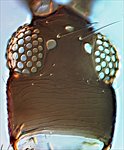Generic diagnosis
Female macropterous. Head longer than wide, prolonged in front of eyes, constricted behind large eyes; maxillary palps 3-segmented; eyes without pigmented facets; ocellar setae I absent, setae III long; five pairs of postocular setae. Antennae 8-segmented; segment I without paired dorso-apical setae, III and IV with long forked sense-cones, III–VI without microtrichia. Pronotum wider than long, without sculpture; two pairs of long posteroangular setae; two pairs of posteromarginal setae. Mesonotum with median pair of setae far from posterior margin; campaniform sensilla present. Metanotum with irregular reticulation; median pair of setae behind anterior margin; campaniform sensilla absent. Fore wing first vein with long gap in setal row, two setae distally; second vein with about five widely spaced setae; clavus with three veinal and one discal setae; posteromarginal fringe cilia wavy. Prosternal ferna entire; basantra membranous, without setae; prospinasternum broad and transverse. Mesosternum with sternopleural sutures complete; endofurca with spinula. Metasternal endofurca without spinula. Tarsi 2-segmented. Tergites without ctenidia or craspeda but II–VII posterior margins laterally with row of dentate microtrichia; VIII with comb complete, long and fine; IX with two pairs of campaniform sensilla, MD setae well developed; X with longitudinal split incomplete. Sternites without discal setae or craspeda; II–VII with three pairs of posteromarginal setae; S1 on VII in front of margin; laterotergites without discal setae.
Male similar to female; antennal segment VI often longer than in female; tergal lateral microtrichia longer than in female, also comb on VIII; tergite IX with two pairs of short stout setae; sternites III–VII with large transversely oval pore plate.
Biological data
Associated with the leaves and flowers of certain Zingiberaceae, particularly Cardamomum and Hedychium, and on the latter recorded as living within rolled leaves (Mound et al, 2017).
Distribution data
Although Oriental in origin, this thrips has been studied from Costa Rica and also Hawaii, and has been reported from southern China (Zhang, 1982).
Nomenclatural data
Sciothrips Bhatti, 1970: 379. Type species Taeniothrips cardamomi Ramakrishna 1935, by monotypy.
Only one species is placed in this genus (ThripsWiki, 2020) and this occurs in China:
cardamomi (Ramakrishna, 1935: 357). (Taeniothrips)
Relationship data
Thripidae sub-family Thripinae: this is a diverse group involving more than 230 genera. The only species in this genus is superficially similar to species of Taeniothrips, but differs in having prominent microtrichia on the tergal posterior margins laterally, and in lacking microtrichia on the antennal segments.
References
Mound LA, Matsunaga J, Bushe B, Hoddle MS & Wells A (2017) Adventive Thysanoptera Species on the Hawaiian Islands: New Records and Putative Host Associations. Proceedings of the Hawaiian Entomological Society 49: 17–28.
Zhang WQ (1982) Preliminary note on Thysanoptera collected from Hainan Island, Guandong, China. I Subfamily: Thripinae (Thysanoptera: Thripidae). Journal of the South China Agricultural College 3 (4): 48–63.
ThripsWiki (2020). ThripsWiki - providing information on the World's thrips. <http://thrips.info/wiki/Main_Page>



